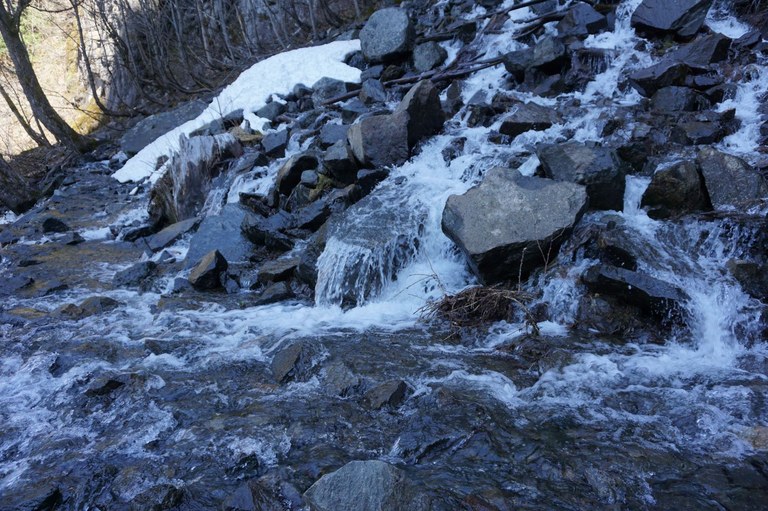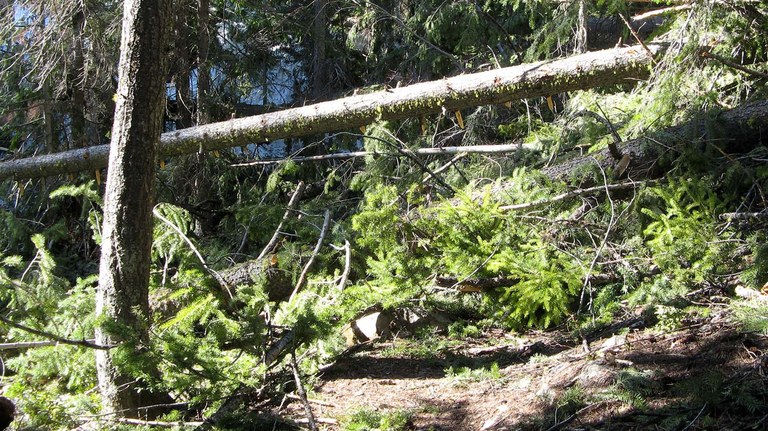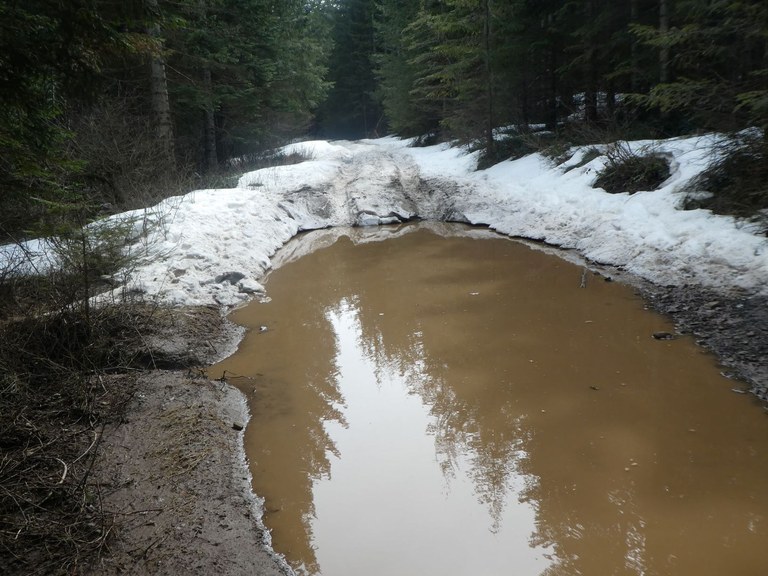Spring Trip Reports: Fallen Trees, Creek Crossings and Mud Oh My
Spring can be an unpredictable time of year — the weather can change in an instant and winter conditions remain on many trails. You may encounter mud, snow, fallen trees, rushing streams and rivers, and avalanche conditions. Trip reports can help you be prepared.
Hiking during the spring is an endlessly rewarding experience. Trails are just waking up after a long winter, flowers are blooming and trees are leafing out.
But spring can be an unpredictable time of year—the weather can change in an instant and winter conditions remain on many trails. You may encounter mud, snow, fallen trees, rushing streams and rivers, and avalanche conditions.

A typical trio of trail conditions during spring: snow, water and ice. Photo by charlie_q.
When it looks like summer out your window, the mountains might still be in winter mode. Thanks to WTA’s community of trip reporters, you can check on trail conditions before leaving home.
Here are some trip reports that illustrate the things you may encounter on a hike this time of year. Write your own trip report to share your findings with other hikers.
Snoquera Falls Loop (Mount Rainier Area): Ice, creek crossings, fallen trees
Trip reporter Hikeswith3 says that Snoquera Falls is looking beautiful with spring flows, but on the trail they encountered one high-flow creek crossing, one icy creek crossing and a tricky blowdown to get around.
Tip: Pack microspikes. If you encounter ice on the trail you can slip them over your boots to get the traction you need.

Ice and water on trail are common obstacles to navigate during spring. Snoquera Falls Trail. Photo by Hikeswith3.
Goat Creek (South Cascades): Snow, creek crossings, fallen trees, mud
Trip reporter LittleAngelsMollie found all the classic spring conditions on their trip to Cathedral Falls. Multiple creek crossings and blowdowns (including two on the road to the trailhead) were the main obstacles, along with one muddy section of trail.
Tip: If you encounter mud on the trail, it's best to walk right through it. Walking around muddy sections damages vegetation on the edges of the trail, resulting in trail widening and erosion.
Cedar Falls (North Cascades): Fallen trees
On their trip to Cedar Falls, trip reporter Rolan encountered some budding wildflowers as well as several jumbles of fallen trees that nearly obscured the entire trail. After scouting the damage, they ate some lunch and headed back to the trailhead.
Tip: Know when to turn back. If you encounter an obstacle that is dangerous or makes finding the trail difficult, it's a good idea to turn around.

Some blowdowns like this one along the Cedar Falls trail are so dense and potentially hazardous that it's not worth it to carry on. Photo by Rolan.
Iron Bear-Teanaway Ridge (Central Cascades): Snow on road
Trip reporter JasonR reminds us that some trailheads are still inaccessible due to snow. They made the smart choice to turn around knowing that their car wouldn’t make it.
Tip: Check trip reports and check with the land manager by looking at their website or giving them a call to get the most up-to-date road conditions.
 Bead Lake (Eastern Washington): Fallen trees
Bead Lake (Eastern Washington): Fallen trees
After navigating over and under a few blowdowns, trip reporter TrailKat was rewarded by wildflowers galore.
Tip: If it's safe to do so, go under or over a fallen tree rather than going around to avoid damaging vegetation on the side of the trail.
May Valley Loop (Issaquah Alps): Minor fallen trees, and no more mud thanks to WTA
Trip reporter sun shine noticed a lack of mud on the Debbie’s View Trail thanks to a reroute completed by WTA’s trail maintenance volunteers (nice work volunteers!). Farther along they found a few small blowdowns that were easy to step over.
Tip: Volunteer on a WTA work party to fix trails so future hikers don't have to worry about mud, puddles or fallen trees.
Silver Lakes (Olympic Peninsula): Snow, ice and creek crossings
Winter conditions persist on this trail according to trip reporter Dragonmountaineer. Their photos show feet of snow making creek crossings difficult. Even without snow, spring creek crossings can be difficult due to high water and bridges that may have been washed out recently.
Tip: Don't underestimate creek crossings. In summer you may skip right over creeks without hardly noticing them, but during the high flows of spring, those same crossings can be difficult or downright dangerous. Check trip reports for the latest information and wear waterproof footwear to keep your feet dry and warm.

High water combined with bridge washouts can make creek crossings a formidable challenge during spring. Photo by Dragonmountaineer.
Larrabee State Park Loop (Bellingham Area): Fallen trees, mud, water on trail
Trip reporter OneHundredMilesAYear shows one section of trail with running water and mud. In another picture, a tree leaning precariously over the trail is a good reminder to always look up for trees or branches that could become a hazard.
Tip: Don't forget to look up. Wind storms, forest fires and other forces can cause trees or branches to become dislodged, but they don't always fall all the way to the ground. Keep an eye out for trees leaning over the trail or loose branches that could fall, especially when selecting a backpacking site. If it's windy, avoid these areas altogether.
Silver Star-Ed’s Trail (Southwest Washington): Puddles, mud, snow
Trip reporter Five Bears parked before the trailhead because they hit snow on the road. Most of the trail was covered in snow so they stopped short of the summit.
Tip: Know your car. Winter road damage is often discovered by spring hikers. If you come upon a washout, huge puddles or snow, don't push your car past what it can handle. Getting stranded on a forest road is no fun.

Sometimes just getting to the trailhead can be the challenge. Checking road conditions before heading out is a good idea during the spring. The road to Ed's Trail. Photo by Five Bears.
Navaho Pass (Snoqualmie Region): Snow, water on trail
This trip reporter encountered snow on the road and decided to walk the last mile rather than drive. They found more snow on the trail, which made it tough to find the way in a couple spots.
Tip: Don't be led astray. If a trail is completely covered in snow it can be difficult to know where to go and it can be tempting to follow footsteps, but the hikers who came before you may not have known where they were going. Bring your own navigational tools and know how to use them to make sure you're on the right path.
Write your own trip report to tell your fellow hikers about the conditions on trail.


Comments